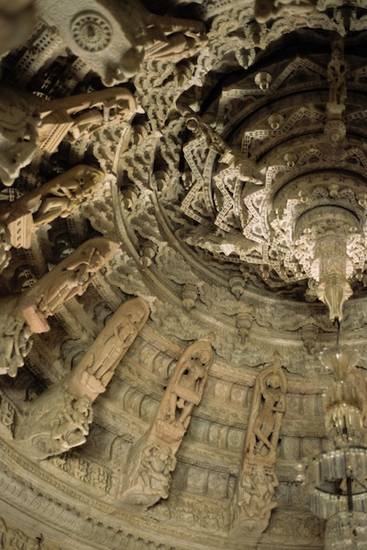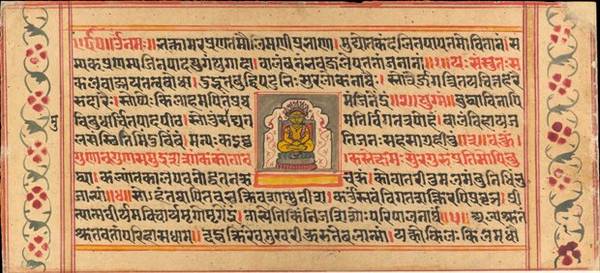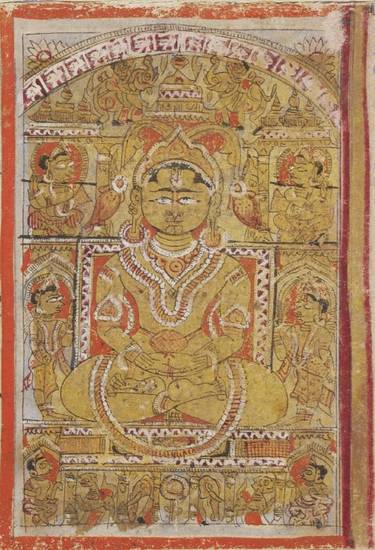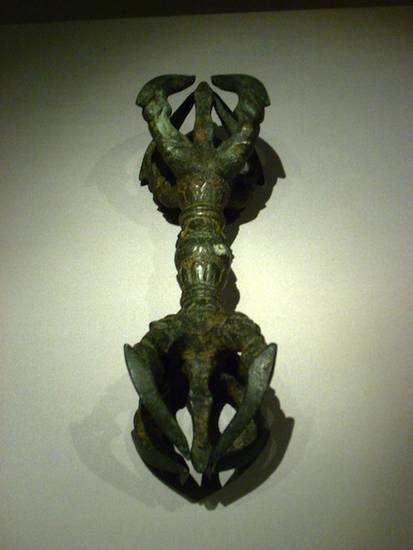Article: Cakreśvarī or Apraticakrā
The yakṣī Cakreśvarī or Apraticakrā is one of the best-known Jain goddesses. She is a śāsana-devatā – ‘deity of the teaching’ – and is believed to help protect and spread the message of her Jina. She is the yakṣī of the first Jina, Ṛṣabhanātha or Lord Ṛṣabha, and a very popular deity who has developed a separate identity as a powerful goddess. Her male counterpart, the yakṣa Gomukha, does not have an independent status.
As a goddess, Cakreśvarī or Apraticakrā is a soul subject to the cycle of birth and can intervene in human affairs, unlike Jinas, who are liberated, perfect souls, completely detached from everyday human experience. Lay Jains worship gods partly to request help with worldly matters, ranging from issues of health and fertility, and passing examinations to business success. By the tenth century several of the śāsana-devatās had developed into independent gods at the centre of their own cults. This may be because of their connections with the major Jinas, links with a prominent pilgrimage centre or various stories of their powers.
Śvetāmbara Jains call this goddess Cakreśvarī while Digambaras know her as Apraticakrā, but this distinction is not watertight. Each sect gives her different attributes, but the disc – cakra – is her distinctive symbol, connected to the two versions of her name. In sculptures as well as paintings she is shown holding it in at least one of her hands. She has close associations with Mount Shatrunjaya, a major Śvetāmbara pilgrimage centre. She is also linked to the popular Jain hymn called the Bhaktāmara-stotra.
Name
This goddess is known as:
- the ‘lord of the disc’ – Cakreśvarī
- the ‘one with a disc without rival’ – Apraticakrā.
In this case, there is a close connection between the yakṣī’s name and her most important symbol. This association can be said to underline her unrivalled power or supremacy.
In addition, Cakreśvarī as a vidyā-devī or ‘goddess of knowledge’ is sometimes called Vaiṣṇavī, the consort of Viṣṇu, whose main emblem is the disc.
Roles

Detail of the Ranakpur dome
Image by w3p706 – Fabian Heusser © CC BY-NC-SA 2.0
Apraticakrā or Cakreśvarī is mainly known as the yakṣī – attendant goddess – of the first Jina, Ṛṣabhanātha or Lord Ṛṣabha. But like many yakṣas and yakṣīs she is at the crossroads of categories. She is also the fifth among the 16 mahā-vidyās or vidyā-devīs, who represent types of magical power or knowledge.
She is ‘parallel in concept to the Hindu goddess Vaiṣṇavī’ (Bruhn 1969: 23), who is the female energy of Viṣṇu. He is the protective, preserver deity of the Hindu triad of major gods and Vaiṣṇavī has similar associations.
Cakreśvarī is also the tutelary deity of the Śvetāmbara monastic lineage of the Ancala-gaccha, along with another goddess named Kālikā.
Appearance
Both yakṣas and yakṣīs are considered part of the entourage of the Jina image, technically known as parikara. Like all of the attendant deities, Cakreśvarī has certain features that help to identify her and indicate her powers. These are described in, for example, texts on the iconography of the Jina, which outline the appearance of the Jina’s attendants.
Being presented as a deity implies that Cakreśvarī has special characteristics linked to the depiction of gods in art. This means she:
- may have more than two arms or hands
- has a vehicle – vāhana
- demonstrates attributes by holding various objects
- may exhibit hand-gestures that symbolise a concept or attitude – mudrās.
Cakreśvarī’s vehicle is Garuḍa, a mythical eagle. Her symbol is the disc – cakra – which is one of the main Indian weapons.
Cakreśvarī is given varying numbers of hands by different traditions within the two main Jain sects, as follows:
- two, four, six, eight, ten, 12, 16 or 20 hands – Digambara
- two, four, eight or 18 hands – Śvetāmbara.
According to the Nirvāṇa-kālikā, she has eight hands. Ascribed to the first quarter of the 11th century, this treatise deals with the installation of images and contains a lot of information about iconography. It states that her four right hands:
- make the gesture of giving a boon – varada-mudrā
- hold an arrow
- carry a disc
- grasp a noose.
Her left hands hold a:
- bow
- thunderbolt – vajra
- disc
- goad.
The sects also give her varying divine attributes. In her 12-hand form, her attributes are identical in the two traditions. They are:
- discs in eight hands
- thunderbolt in two hands
- fruit and varada-mudrā in the two remaining hands.
A 14th-century work says:
On both sides [of the frame of the jina image] there should be yakṣa, yakṣī, lions, elephants, caurī, and in the middle the goddess Cakreśvarī. These should occupy fourteen, twelve, ten, three, and six parts respectively of the whole [frame]
Vatthusāra-payaraṇa II. 27
quoted in Fischer and Jain 1978, volume II, page 22
Written in the 12th century, Hemacandra’s standard Śvetāmbara version of the lives of the 24 Jinas contains a paragraph for each pair of gods attendant on the Jinas. Here is the description he gives of Cakreśvarī:
Apraticakrā, gold-color, with a garuḍa-seat, with one right arm in varada-position and the others holding an arrow, disc, and noose, her left arms holding a bow, thunderbolt, disc, and goad
Hemacandra, Triṣaṣṭiśalākāpuruṣacaritra I.3.279ff.
Johnson’s translation, volume I, page 211
There is also a terrifying form of Cakreśvarī depicted in Tantric texts. She has the same attributes but ‘is visualized as three-eyed with dreadful appearance’ (Tiwari and Sinha 2011: 91).
Images
The earliest image of the goddess Cakreśvarī with an identifying caption is considered to be the sculpture on the façade of temple number 12 at Deogarh, which is dated 862 CE. The peak creation period for surviving Cakreśvarī figures is the tenth to 12th centuries, especially in central India. Sites such as Deogarh or Khajuraho in Madhya Pradesh have yielded individual images of her, pointing to the existence of independent worship at that time.
Important images are the:
- 11th-century Cakreśvarī with 20 arms preserved in the Sahu Jaina Museum at Deogarh (Tiwari and Sinha 2011: 92 and plate 122)
- four-armed Cakreśvarī seated on a human garuḍa, found in temple number 19 at Deogarh (Bruhn 1969: figure 250).
Another one is the Cakreśvarī in cave temple 30 at Ellora, Maharashtra, dating from the ninth century. There she has 12 arms and rides on a garuḍa in human form. South Indian images rarely show the eagle as a vehicle, but the disc is always present.
In western India, noteworthy figures of Cakreśvarī are a:
- marble image with eight arms in a niche to the left of the steps leading to the Caumukha Tunka in Shatrunjaya (Jhavery 1944: 330) in Gujarat
- four-armed image in the temple of Vastupāla and Tejaḥpāla on Mount Girnar, also in Gujarat.
Describing Ayodhyā as a Jain holy place in section 13 of his 14th-century Vividha-tīrtha-kalpa, Jinaprabha-sūri, the Śvetāmbara author, implies that there was an idol of her and of the yakṣa Gomukha in a shrine at Shatrunjaya.
In the 11th century the worship of Cakreśvarī is said to have led the businessman Jāvaḍa Śeṭh to rediscover an image of R̥ṣabhanātha or Lord R̥ṣabha. This subsequently led to the re-establishment of Shatrunjaya as a holy place (Cort 1987: 241).
Cakreśvarī is thus associated with this major pilgrimage centre for Śvetāmbara Jains. She is considered the site’s protective deity and there is a small shrine to her there. The development of her cult is linked to the growth of the pilgrimage site.
Bhaktāmara-stotra

Bhaktāmara-stotra opening
Image by British Library © CC0 1.0 (Creative Commons Public Domain)
Cakreśvarī appears as a major figure in many of the stories relating to the Bhaktāmara-stotra, one of the most famous Jain hymns.
Dedicated to the first Jina, Ṛṣabhanātha or Lord Ṛṣabha, the hymn has given rise to numerous accounts demonstrating the positive effects of reciting it. The tales featuring Cakreśvarī all show how she is instrumental in helping the devout Jain who is meditating on this hymn and reciting its verses. When she is satisfied with his devotion, she appears in front of him, gives him a boon and then disappears. This boon reverses the worshipper’s difficult position and determines his future success in life.
Worship
Evidence from the tenth century demonstrates that at that point the worship of independent yakṣīs was already well established and important.
Devotees call upon these individual divinities to remove all sorts of obstacles and bestow success in all areas of life. Independent hymns of praise develop as a form of literature. One instance is the Cakreśvarī-stotra, written by Jinadatta-sūri in the 12th century (Nawab 1937/1996: 182–183; Jhavery 1944: 331–332).
Tantric rituals

Worship of Ṛṣabha
Image by Victoria and Albert Museum © V&A Images/Victoria and Albert Museum, London
The individual yakṣīs are also associated with magic or occult practices. Hence there are Tantric modes of worship associated with them as well. This implies propitiatory rituals meant to invite the benevolence of the deity. Unlike more orthodox Jain rites, worshippers invoke the goddess under her different names and visualise her using mantras to assist meditation. They perform various rites with the help of yantras, intended to appease evil forces and win the favour of the goddess.
Such mantras, yantras and ceremonies are given in works that may take the form of hymns of praise composed in Sanskrit. Of unknown date and authorship, the Cakreśvarī-aṣṭaka (Nawab 1937/1996: 184–185 and Jhavery 1944: 331–332) is one such example.
However, this type of worship is probably less prominent for Cakreśvarī than it is for other important yakṣīs such as:
Reading
- The Jaina Iconography
B. C. Bhattacharya - Motilal Banarsidass; Delhi, Varanasi, Uttar Pradesh and Patna, Bihar in India; 1974
- ‘The Goddesses of Sravana Belgola’
John E. Cort - Svasti – essays in honour of Prof. Hampa Nagarajaiah for his 75th Birthday
edited by Nalini Balbir
Muddushree Granthamala series; volume 75
K. S. Muddappa Smaraka Trust; Bangalore, Karnataka, India; 2010
- The Jains
Paul Dundas - Library of Religious Beliefs and Practices series; series editor John Hinnels and Ninian Smart; volume 14
Routledge Curzon Press; London, UK; 2002
- Life in Ancient India as depicted in Jaina Canon and Commentaries: 6th Century BC to 17th Century AD
Jagdischchandra Jain - Munshiram Manoharlal; Delhi, India; 1984
- Vividhatīrthakalpa
Jinaprabhasūri - edited by Muni Jinavijaya
Singhi Jain series; volume 10
Shantiniketan; Bombay, India; 1934
- Vividha Kalpa Saṃgraha: Mul, gujarātī bhāṣāntara, mantra-yantra-tantra no saṃgraha pariśiṣṭo sāthe
Nawab Sarabhai Manilal and Nawab Rajendra Sarabhai - Śrī Jaina kalā sāhitya saṃśodhana granthamālā series; volume 22
Amadāvāda; Ahmedabad, Gujarat, India; 1998
- Śrī Bhairavapadmāvatīkalpa: śrīBandhuṣeṇa nī vistṛta ṭīkā tathā śuddha mantragarbhita 31 pariśiṣṭo sahita [aneka yantrakṛtio sāthe] dvitīya saṃvṛddhita āvṛtti [ādya sampādaka Sva. Prof. K.V. Abhyankar]
Malliṣeṇasūriviracita - Nawab Sarabhai Manilal; Ahmedabad, Gujarat, India; 1996
- The Jain Saga: 63 Illustrious Persons of the Jain World, Brief History of Jainism
Hemacandra - translated by Helen M. Johnson
edited by Muni Samvegayashvijayji Maharaj
Acharya Shrimad Vijay Ramchandra Suriswarji Jain Pathshala; Ahmedabad, Gujarat and Mumbai, Maharashtra, India; 2009
- ‘Göttinverehrung im Jainismus’
Robert J. Zydenbos - Aspekte der Weiblichen in der indischen Kultur
edited by Ulrike Roesler
Indica et Tibetica series; volume 39
Indica et Tibetica; Swisttal-Odendorf, North-Rhine-Westphalia, Germany; 2000
Links
- Cakreśvarī
-
Contemporary Śvetāmbara painting on Flickr of the goddess Cakreśvarī or Apraticakrā. She stands on her vehicle, the garuḍa or mythical eagle, and holds in two of her eight hands the disc – cakra – that gives her her name. As well as being the yakṣī – female attendant – to the first Jina, Ṛṣabha, she is a powerful goddess in her own right.
- Cakreśvarī wearing robes
-
Decorated Śvetāmbara statue of the goddess Cakreśvarī or Apraticakrā. She wears richly embroidered clothes and ornate jewellery, including a headdress. She is the yakṣī – female attendant – of the first Jina, Ṛṣabha, and has also developed into a popular independent goddess. This photograph of a contemporary image in the Dada Bari Jain Mandir, Mehraul, New Delhi, is available on Flickr.
- Cakreśvarī
-
Contemporary Śvetāmbara painting on Flickr of the goddess Cakreśvarī or Apraticakrā. She stands on her vehicle, the garuḍa or mythical eagle, and holds in two of her eight hands the disc – cakra – that gives her her name. As well as being the yakṣī – female attendant – to the first Jina, Ṛṣabha, she is a powerful goddess in her own right.
- Cakreśvarī at Ellora
-
The Ellora Caves project presents this photograph of an early Digambara figure of the goddess Cakreśvarī, found in cave 30 of the cave temples at Ellora, Maharashtra. The yakṣī of the first Jina, Ṛṣabhanātha or Lord Ṛṣabha, Cakreśvarī's power is symbolised in the weapon of the disc – cakra – from which she gets her name.
http://elloracaves.org/caves.php?cmd=search&words=&cave_ID=30&plan_floor=1&image_ID=2656
- +
- aAbhavya
- aAbhinandana
- aAbhiṣeka
- aĀcāra
- aĀcārāṅga-sūtra
- aĀcārya
- aAchalbhrata
- aAḍhāī-dvīpa
- aAdharma
- aAdho-loka
- aAdhyayana
- aAdvaita Vedānta
- aĀgama
- aAghātīya
- aAghātīya-karman
- aAgnibhuti
- aAgra
- aĀhāra
- aAhiṃsā
- aAhimsa Day
- aAjita
- aAjīva
- aAkampit
- aĀkāśa
- aAkbar the Great
- aAkṣaya-tṛtīyā
- aAlauddin Khalji
- aAlbert Einstein
- aAllah
- aAlms
- aĀlocanā
- aAloka-ākāśa
- aAmāri
- aAmbikā or Kūṣmāṇḍinī
- aAnagāra
- aAnanta
- aAnarthadaṇḍa
- aAnaśana
- aAnekānta-vāda
- aAṅga
- aAniconism
- aAnojjā
- aAntarāla
- aAntarāya-karma
- aAṇu
- aAṇu-vrata
- aAnukampā
- aAnuprekṣā
- aAnusvāra
- aApabhraṃśa
- aAparigraha
- aAra
- aĀrambha
- aĀrambhaja
- aĀratī
- aArdhamāgadhī Prākrit
- aArhaṃ
- aArhat
- aArśana-āvaraṇīya-karma
- aĀrta-dhyāna
- aĀryikā
- aĀryikā Jñānamati
- aĀśātanā
- aĀścarya
- aAscetic
- aAsceticism
- aAshram
- aAspiration
- aĀsrava
- aAṣṭa-maṅgala
- aAṣṭāpada
- aAstikāya
- aAstrolabe
- aAsura
- aAtheism
- aAticāra
- aAtiśayakṣetra
- aAtithisaṃvibhāgavrata
- aĀtma-vāda
- aĀtman
- aAuṃ
- aAurangzeb
- aAuspicious
- aAusterity
- aAvadhāna
- aAvadhi-jñāna
- aĀvaraṇī-yakarman
- aAvasarpiṇī
- aAvatāra
- aAvidyā
- aAxiom
- aĀyāga-paṭa
- aĀyambil
- aĀyu-karma
- aĀyurveda
- bBabur
- bBāhubali
- bBaladeva
- bBālāvabodha
- bBandha
- bBasadi
- bBazaar
- bBhadrankarvijay
- bBhagavant
- bBhaktāmara-stotra
- bBhakti
- bBhale
- bBharata
- bBhāṣā
- bBhāṣya
- bBhaṭṭāraka
- bBhāva
- bBhāva-pūjā
- bBhāvanā
- bBhavana-vāsin
- bBhavya
- bBhavyatva
- bBhaya
- bBhoga-bhūmi
- bBhogopabhoga
- bBodhi
- bBollywood
- bBrahmā
- bBrahma-deva
- bBrahmacārī
- bBrāhmaṇa
- bBraj Bhāṣā
- bBright fortnight
- bBritish Raj
- bBuddha
- bBuddhi-sagar
- bBuddhism
- bBuddhist
- cCaitya
- cCaityavāsin
- cCakravartin
- cCakreśvarī
- cCāmara
- cCandanā
- cCandragupta
- cCandraprabha
- cCanon
- cCāritra
- cCāritramohanīya-karman
- cCarũrī
- cCaste
- cCaturvidha-saṅgha
- cCaturviṃśati-stava
- cCāturyāma
- cCE
- cCelibacy
- cCha
- cChadmastha
- cChastity
- cCheda-sūtra
- cChristian
- cChristianity
- cClergy
- cCloning
- cColophon
- cCommentary
- cConch
- cConfession
- cCongregation
- cConsecration
- cCosmology
- cCremation
- cCrore
- cCult
- cCūrṇi
- dDādā-guru
- dDalit
- dDāna
- dDaṇḍa
- dDark fortnight
- dDarśana
- dDarśanamohanī-yakarman
- dDaśa-lakṣaṇa-parvan
- dDeity
- dDelhi Sultanate
- dDerāsar
- dDeśāvakāśika-vrata
- dDetachment
- dDevanāgarī
- dDevānandā
- dDevarddhi-gani
- dDevotee
- dDhamal
- dDhanuṣ
- dDhāra
- dDharma
- dDharma-dhyāna
- dDharma-sāgara
- dDharmastikaya
- dDhātakīkhaṇḍa
- dDholak
- dDhyāna
- dDiaspora
- dDig-vrata
- dDigambara
- dDīkṣā
- dDisciple
- dDīvālī
- dDivya-dhvani
- dDNA
- dDoctrine
- dDogma
- dDonor
- dDoṣa
- dDravya
- dDravya-pūjā
- dDrone
- dDuṣamā
- dDuṣamā-duṣamā
- dDuṣamā-suṣamā
- dDveṣa
- dDvīpa
- eEast India Company
- eEightfold Path
- eEkānta-vāda
- eEkendriya
- eElder
- eElders
- eEschatology
- eEtc up to
- fFarmān
- fFast
- fFatehpur Sikri
- fFestival
- fFestschrift
- fFiruz Shah
- fFly-Whisks
- fFolio
- fFour Noble Truths
- gGaccha
- gGaṇa
- gGaṇadhara
- gGanadharavada
- gGaṇeśa
- gGaṇin
- gGarba
- gGarbha
- gGarbha-gṛha
- gGaruḍa
- gGati
- gGene
- gGenomics
- gGhātī-yakarman
- gGhātīya
- gGhaznavid
- gGhiyasuddin Tughlaq
- gGhurid
- gGloss
- gGotra-karma
- gGujarāt
- gGujarati
- gGuṇa
- gGuṇa-sthāna
- gGuṇa-vrata
- gGupti
- gGuru
- gGuruṇī
- hHagiography
- hHajj
- hHaṃsa
- hHaribhadra
- hHariṇaigameṣin
- hHasta
- hHeresy
- hHiṃsā
- hHindi
- hHindu
- hHinduism
- hHīravijaya
- hHoroscope
- hHrīṃ
- hHumayun
- hHymn
- iIconoclasm
- iIconography
- iIdol
- iIndian Independence
- iIndology
- iIndra
- iIndrabhūti Gautama
- iIndriya
- iInitiation
- iIntercession
- iInvocation
- iIQ
- iIslam
- iIslamicate
- iIṣṭadevatā
- iĪśvara
- jJagat
- jJahangir
- jJain
- jJaina Devanāgarī
- jJaina Śaurasenī
- jJaina-dharma
- jJainaśāsana
- jJainness
- jJaisalmer
- jJamāli
- jJambū-dvīpa
- jJames Burgess
- jJanma
- jJanma-kalyāṇa
- jJarā
- jJāti
- jJina
- jJina-āgama
- jJina-bhavana
- jJina-bimba
- jJina-mātā
- jJinacandra-sūri
- jJinadatta
- jJinaprabha
- jJīva
- jJñāna
- jJñāna-āvaraṇīya-karma
- jJñāna-āvarṇiya
- jJñānsundar
- jJyotiṣka
- kKāla
- kKālakācārya-kathā
- kKālidāsa
- kKalpa-sūtra
- kKalpa-vṛkṣa
- kKalyāṇaka
- kKalyanvijay
- kKamaṇḍalu
- kKamaṭha
- kKarma
- kKarma-bhūmi
- kKarma-grantha
- kKarma-prakṛti
- kKarma-vāda
- kKarmon
- kKarnataka
- kKaṣāya
- kKathā
- kKāvya
- kKāya
- kKāyotsarga
- kKeśa-loca
- kKetu
- kKevala-jñāna
- kKevalin
- kKhalji
- kKharatara-gaccha
- kKnowledge
- kKriyā
- kKriyā-vāda
- kKṛṣṇa
- kKṣamā-śramaṇa
- kKṣapakaśreṇi
- kKṣatriya
- kKṣullaka
- kKulakara
- kKundakunda
- kKunthu
- lLabdhi
- lLaity
- lLakh
- lLāñchana
- lLands of Action
- lLaukāntika
- lLavaṇa-samudra
- lLeśyā
- lLiṅga
- lLinguistics
- lLoka
- lLoka-ākāśa
- lLoka-puruṣa
- lLoka-vāda
- lLotus
- lLotus lake
- mMadhya-loka
- mMahā-videha
- mMahā-vrata
- mMahābhārata
- mMahāmastakābhiṣeka
- mMāhārāṣṭra
- mMāhārāṣṭrī Prākrit
- mMahattarā Yākinī
- mMahāvīr Jayantī
- mMahāvīra
- mMakāra
- mMakkhali Gośāla
- mMalli
- mMāna-stambha
- mManaḥ-paryāya-jñāna
- mMaṇḍala
- mMaṇḍapa
- mMandit
- mMaṅgala
- mMantra
- mMantras
- mManuṣya-loka
- mMarāṭhī
- mMārgaṇā
- mMartyr
- mMarudevī
- mMaṭha
- mMati-jñāna
- mMauryaputra
- mMecca
- mMendicant lineage
- mMetarya
- mMiracle
- mMithyādṛṣṭi
- mMohandas Gandhi
- mMohanīya-karma
- mMokṣa
- mMonastic order
- mMonasticism
- mMonk
- mMonotheism
- mMosque
- mMount Meru
- mMount Sammeta
- mMṛgāvatī
- mMughal
- mMuhammad
- mMuhammad bin Tughlaq
- mMuhpattī
- mMūla-sūtra
- mMūlaguṇa
- mMumbaī
- mMuni
- mMunisuvrata
- mMurad Bakhsh
- mMūrti-pūjaka
- mMuslim
- mMysticism
- nNābhi
- nNāga-kal
- nNāgapurīya Tapā-gaccha
- nNāgarī
- nNāma-karma
- nNamaskāra-mantra
- nNami
- nNandīśvara-dvīpa
- nNandivardhana
- nNandyāvarta
- nNāraka
- nNāraki
- nNasalisation
- nNātha
- nNavrātrī
- nNaya-vāda
- nNemi
- nNidāna
- nniggaṃthāṇa vā 2
- nniggaṃtho vā 2
- nNigoda
- nNihnava
- nNikṣepa
- nNirgrantha
- nNirjarā
- nNirvāṇa
- nNiryukti
- nNiṣidhi
- nNitya
- nNiyati
- nNo-kaṣāya
- nNudity
- nNun
- oOcean of milk
- oOmniscience
- oOrdination
- ppa°
- pPadmaprabha
- pPadmāsana
- pPadmāvatī
- pPādukā
- pPalanquin
- pPalette
- pPañca-muṣṭi
- pPāṇḍava
- pPaṇḍit
- pPandit Dalsukh D. Malvania
- pPandit Sukhlalji
- pPāṇipātra
- pPāpa
- pParamātman
- pParameṣṭhin
- pPāraṇā
- pParigraha
- pPariṇāma
- pParīṣaha
- pParokṣa
- pPārśva
- pPārśvanātha
- pParyāya
- pParyuṣaṇ
- pPaṭa
- pPatan
- pPātra
- pPenance
- pPersian
- pPhala
- pPhilology
- pPicchikā
- pPilgrimage
- pPīr
- pPolymath
- pPoṣadha
- pPossession
- pPothī
- pPrabhas
- pPradakṣiṇā
- pPradeśa
- pPrākāra
- pPrakīrṇaka-sūtra
- pPrākrit
- pPramāda
- pPramukhā
- pPrati-vāsudeva
- pPratikramaṇa
- pPratimā
- pPratiṣṭhā
- pPratyākhyāna
- pPratyakṣa
- pPravacana
- pPrāyaścitta
- pPrayer
- pPre-modern
- pPreach
- pPredestination
- pProtestant
- pProvenance
- pPudgala
- pPūjā
- pPujārī
- pPukharavara-dvīpa
- pPuṇya
- pPūrva
- pPuṣkara-dvīpa
- pPuṣpadanta
- pPyre
- qQur’an
- rRāga
- rRāhu
- rRainy season
- rRajasthan
- rRajasthani
- rRājimatī
- rRajoharaṇa
- rRajput
- rRāma
- rRāmāyaṇa
- rRangoli
- rRās-garbā
- rRasa
- rRathanemi
- rRatna-traya
- rRātri-bhojana
- rRaudra-dhyāna
- rRecto
- rRelic
- rRenunciation
- rRetroflex
- rRevatī
- %Ṛg-veda
- rRite
- rRosary
- %Ṛṣabha
- %Ṛṣabhanātha
- rRupee
- sSaciyā Mātā
- sSādhu
- sSādhvī
- sSāgāra
- sSaint
- sŚaivaism
- sŚaka-saṃvat
- sSallekhanā
- sŚalya
- sSamacatuṣṭha
- sSamādhimaraṇa
- sSamaṇi
- sSāmarambha
- sSamavasaraṇa
- sSāmāyika
- sSaṃbhava
- sSamiti
- sSaṃjñā
- sSaṃkalpaja
- sSaṃsāra
- sSamudghāta
- sSaṃvara
- sSaṃvega
- sSamyak-cāritra
- sSamyak-darśana
- sSamyak-jñāna
- sSamyaktva
- sSaṃyama
- sSanctuary
- sSandalwood
- sSaṇgha
- sSanskrit
- sSant
- sŚānti
- sSapta-bhaṅgi-naya
- sSārambha
- sSarasvatī
- sSarvajña
- sSāsan-devi
- sŚāsana-devatā
- sŚāstra
- %Ṣaṭ-jīvanikāya
- sSatī
- sSatīmātā
- sSatya
- sSchism
- sScribe
- sScripture
- sSect
- sSecularism
- sŚenāī
- sSermon
- sŚeṣavatī
- sSevā
- sSeven fields of donation
- sShah Jahan
- sShantidas Jhaveri
- sShrine
- sSiddha
- sSiddha-śilā
- sSiddhacakra or Navadevatā
- sSiddhānta
- sSiddhārtha
- sSiddhi
- sSikh
- sSikhism
- sŚikṣā-vrata
- sŚīla
- sSin
- sSindh
- sŚītala
- sŚiva
- sSkandha
- sSomanatha
- sŚraddhā
- sŚramaṇa
- sŚrāvaka
- sŚrāvakācāra
- sŚrāvikā
- sŚreyāṃsa
- sŚrī
- sŚrīvatsa
- sŚruta-jñāna
- sŚruta-pañcamī
- sSthānaka-vāsin
- sSthāpanācārya
- sSthāvara
- sSthavira
- sSthiti
- sStrīmukti
- sStūpa
- sSubcontinent
- sSudarshana
- sŚuddhi
- sSudharma
- sŚūdra
- sSufism
- sSukha
- sŚukla-dhyāna
- sSulasā
- sSultan
- sSumati
- sSundarśrī
- sSupārśva
- sSūri
- sSuṣamā
- sSuṣamā-duṣamā
- sSuṣamā-suṣamā
- sSūtra
- sSuyam me ausam! Tenam bhagavaya evamakkhayam
- sSvādhyāya
- sSvāhā
- sSvastika
- sŚvetāmbara
- sŚvetāmbara Terāpanthin
- sŚvetāmbaras
- sSwan
- sSyād-vāda
- tTabla
- tTantra
- tTapā-gaccha
- tTapas
- tTāraṇ Svāmī Panth
- tTattva
- tTattvārtha-sūtra
- tTemple
- tTemple-city
- tThe Enlightenment
- tTheology
- tThree worlds
- %Ṭīkā
- tTilaka
- tTīrtha
- tTīrthaṃkaranāma-karman
- tTīrthankara
- tTransliteration
- tTrasa
- tTrasa-nāḍī
- tTriśalā
- tTriṣaṣṭi-śalākā-puruṣa-caritra
- tTti bemi
- tTughlaq
- tTunk
- uUdumbara
- uUniversal History
- uUpādhyāya
- uUpāṅga
- uUpaniṣads
- uUpāsaka
- uUpasarga
- uUpāśraya
- uŪrdhva-loka
- uUtsarpiṇī
- uUttarādhyayana-sūtra
- vVāhana
- vVaimānika
- vVairāgya
- vVaiṣṇava
- vVaiśramaṇa
- vVaiśya
- vValabhī
- vVanaspatikāya
- vVandana
- vVaṇik
- vVarṇa
- vVāsudeva
- vVāsupūjya
- vVayubhūti
- vVeda
- vVedanīya-karma
- vVegetarianism
- vVehicle
- vVernacular
- vVerso
- vVidyā
- vVidyā-devī
- vVihāra
- vVijñapti-patra
- vVikrama-saṃvat
- vVikṛti
- vVimala
- vVinaya
- vVipāka
- vVirji Vora
- vVirodhaja
- vVīrya
- vVisarga
- vViṣṇu
- vVītarāga
- vVizier
- vVotive
- vVow
- vVrata
- vVS
- vVyakta
- vVyantara
- vVyasana
- yYakṣa
- yYakṣī
- yYantra
- yYaśoda
- yYaśovijaya
- yYati
- yYātrā
- yYoga
- yYoginī
- yYojana








